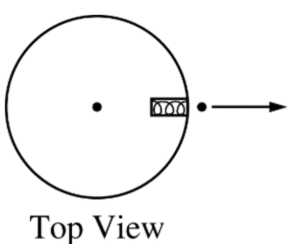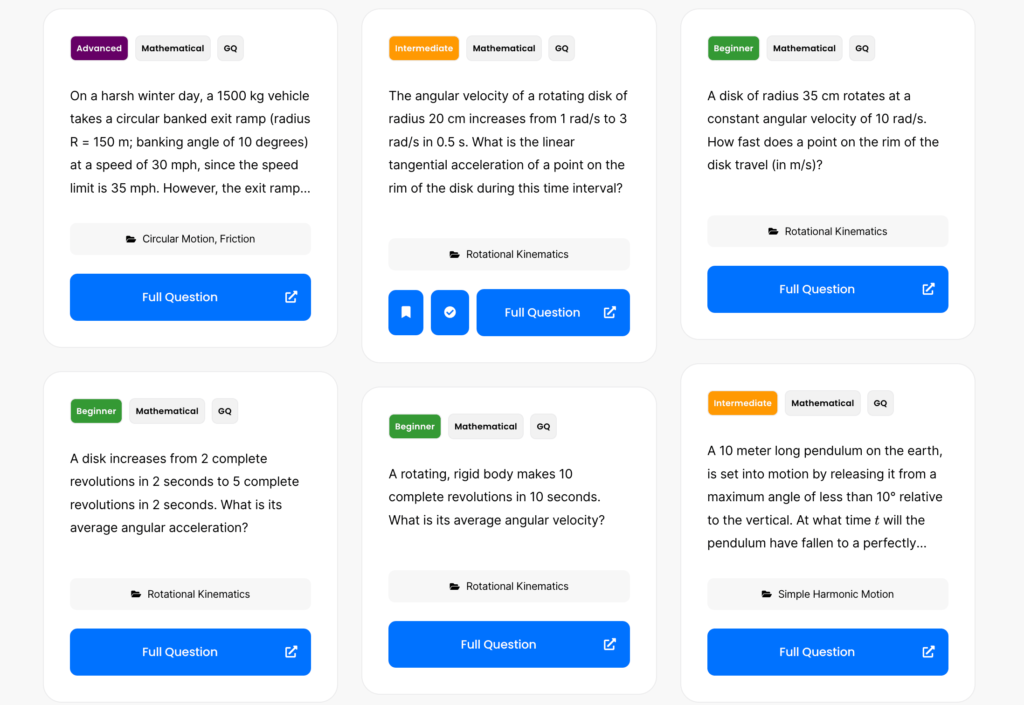0 attempts
0% avg
UBQ Credits
| Step | Derivation/Formula | Reasoning |
|---|---|---|
| A1 | [katex] T – Mg = \frac{Mv^2}{L} [/katex] | This is the force equilibrium equation at the bottom point. [katex] T [/katex] is the tension in the string, [katex] M [/katex] is the mass of the ball, [katex] g [/katex] is the acceleration due to gravity, [katex] v [/katex] is the velocity of the ball, and [katex] L [/katex] is the length of the string. |
| A2 | [katex] T = 3Mg [/katex] | The tension at the bottom is given to be three times the weight of the ball. |
| A3 | [katex] 3Mg – Mg = \frac{Mv^2}{L} [/katex] | Substituting the tension value into the equilibrium equation. |
| A4 | [katex] v = \sqrt{2gL} [/katex] | Simplifying the equation for [katex] v [/katex], observe [katex] M [/katex] cancels out. This is velocity at any given point around the circle. |
| A5 | [katex] F_{\text{centripetal}} = \frac{Mv^2}{L} [/katex] | At the top, we can use the velocity calculated in the previous step to find the centripetal force required to keep the ball moving in the circle. |
| A6 | [katex] 2mg [/katex] | Substitute in the equation for velocity (from step A4) so that the final equation is in terms of [katex] M \, g \, L [/katex] |
| B1 | [katex] v_{\text{top}} = \sqrt{v^2 – 4gL} [/katex] | Using conservation of energy. [katex] KE_{\text{bottom}} + PE_{\text{bottom}} = KE_{\text{top}} + PE_{\text{top}} [/katex]. The velocity at the top is found by noting the potential energy difference between top and bottom. Simplify by substituting [katex] v [/katex] from A4. |
| B2 | [katex] v_{\text{top}} = \sqrt{2gL – 4gL} [/katex] | [katex] = \sqrt{-2gL} \rightarrow [/katex] which is zero since [katex] 2gL > 4gL [/katex] |
| C1 | [katex] t = \sqrt{\frac{4L}{g}} [/katex] | Ball falls freely under gravity and has no initial vertical velocity, so [katex] \delta y = \frac{1}{2}gt^2 [/katex]; solving for [katex] t [/katex] gives the time to fall a distance [katex] L [/katex]. Note that the displacement from the top to the bottom is twice the radius of the circle or [katex] 2L [/katex]. |
| D1 | [katex] \Delta x = v_0t [/katex] | The horiztontal distance traveled by any projectile is the product of the horiztonal speed and the time in air. |
| D2 | [katex] \sqrt{2gL} \times \sqrt{\frac{4L}{g}} [/katex] | Substitute in velocity from Step A4 and time from step C1 |
| D3 | [katex] \sqrt{8}L [/katex] | Simplify |
(a) The net force on the ball at the top is [katex] 2Mg [/katex], downward.
(b) The velocity of the ball at the top is [katex] v = \sqrt{2gL} [/katex].
(c) The time it takes to reach the ground is [katex] \sqrt{\frac{4L}{g}} [/katex].
(d) The horizontal distance traveled is [katex] \sqrt{8}L [/katex]
Just ask: "Help me solve this problem."
A \(2.2 \times 10^{21} \, \text{kg}\) moon orbits a distant planet in a circular orbit of radius \(1.5 \times 10^8 \, \text{m}\). It experiences a \(1.1 \times 10^{19} \, \text{N}\) gravitational pull from the planet. What is the moon’s orbital period in Earth days?

A compressed spring mounted on a disk can project a small ball. When the disk is not rotating, as shown in the top view above, the ball moves radially outward. The disk then rotates in a counterclockwise direction as seen from above, and the ball is projected outward at the instant the disk is in the position shown above. Which of the following best shows the subsequent path of the ball relative to the ground?
A projectile is launched at an angle of \( 30^{\circ} \) and hits a vertical wall \( 40 \) \( \text{m} \) away. After bouncing back horizontally, it lands \( 15 \) \( \text{m} \) behind the launch point. How high up on the wall did the projectile strike?
The ultracentrifuge is an important tool for separating and analyzing proteins. Because of the enormous centripetal accelerations, the centrifuge must be carefully balanced, with each sample matched by a sample of identical mass on the opposite side. Any difference in the masses of opposing samples creates a net force on the shaft of the rotor, potentially leading to a catastrophic failure of the apparatus. Suppose a scientist makes a slight error in sample preparation and one sample has a mass \( 10 \) \( \text{mg} \) larger than the opposing sample.
If the samples are \( 12 \) \( \text{cm} \) from the axis of the rotor and the ultracentrifuge spins at \( 60000 \) \( \text{rpm} \), what is the magnitude of the net force on the rotor due to the unbalanced samples?
You must split an apple resting on top of you friend’s head from a distance of 27 m. When you aim directly at the apple, the arrow is horizontal. At what angle should you aim the arrow to hit the apple if the arrow travels at a speed of 35 m/s?
(a) [katex] 2Mg [/katex], downward.
(b) [katex] v = \sqrt{2gL} [/katex].
(c) [katex] \sqrt{\frac{4L}{g}} [/katex].
(d) [katex] \sqrt{8}L [/katex]
By continuing you (1) agree to our Terms of Use and Terms of Sale and (2) consent to sharing your IP and browser information used by this site’s security protocols as outlined in our Privacy Policy.
| Kinematics | Forces |
|---|---|
| \(\Delta x = v_i t + \frac{1}{2} at^2\) | \(F = ma\) |
| \(v = v_i + at\) | \(F_g = \frac{G m_1 m_2}{r^2}\) |
| \(v^2 = v_i^2 + 2a \Delta x\) | \(f = \mu N\) |
| \(\Delta x = \frac{v_i + v}{2} t\) | \(F_s =-kx\) |
| \(v^2 = v_f^2 \,-\, 2a \Delta x\) |
| Circular Motion | Energy |
|---|---|
| \(F_c = \frac{mv^2}{r}\) | \(KE = \frac{1}{2} mv^2\) |
| \(a_c = \frac{v^2}{r}\) | \(PE = mgh\) |
| \(T = 2\pi \sqrt{\frac{r}{g}}\) | \(KE_i + PE_i = KE_f + PE_f\) |
| \(W = Fd \cos\theta\) |
| Momentum | Torque and Rotations |
|---|---|
| \(p = mv\) | \(\tau = r \cdot F \cdot \sin(\theta)\) |
| \(J = \Delta p\) | \(I = \sum mr^2\) |
| \(p_i = p_f\) | \(L = I \cdot \omega\) |
| Simple Harmonic Motion | Fluids |
|---|---|
| \(F = -kx\) | \(P = \frac{F}{A}\) |
| \(T = 2\pi \sqrt{\frac{l}{g}}\) | \(P_{\text{total}} = P_{\text{atm}} + \rho gh\) |
| \(T = 2\pi \sqrt{\frac{m}{k}}\) | \(Q = Av\) |
| \(x(t) = A \cos(\omega t + \phi)\) | \(F_b = \rho V g\) |
| \(a = -\omega^2 x\) | \(A_1v_1 = A_2v_2\) |
| Constant | Description |
|---|---|
| [katex]g[/katex] | Acceleration due to gravity, typically [katex]9.8 , \text{m/s}^2[/katex] on Earth’s surface |
| [katex]G[/katex] | Universal Gravitational Constant, [katex]6.674 \times 10^{-11} , \text{N} \cdot \text{m}^2/\text{kg}^2[/katex] |
| [katex]\mu_k[/katex] and [katex]\mu_s[/katex] | Coefficients of kinetic ([katex]\mu_k[/katex]) and static ([katex]\mu_s[/katex]) friction, dimensionless. Static friction ([katex]\mu_s[/katex]) is usually greater than kinetic friction ([katex]\mu_k[/katex]) as it resists the start of motion. |
| [katex]k[/katex] | Spring constant, in [katex]\text{N/m}[/katex] |
| [katex] M_E = 5.972 \times 10^{24} , \text{kg} [/katex] | Mass of the Earth |
| [katex] M_M = 7.348 \times 10^{22} , \text{kg} [/katex] | Mass of the Moon |
| [katex] M_M = 1.989 \times 10^{30} , \text{kg} [/katex] | Mass of the Sun |
| Variable | SI Unit |
|---|---|
| [katex]s[/katex] (Displacement) | [katex]\text{meters (m)}[/katex] |
| [katex]v[/katex] (Velocity) | [katex]\text{meters per second (m/s)}[/katex] |
| [katex]a[/katex] (Acceleration) | [katex]\text{meters per second squared (m/s}^2\text{)}[/katex] |
| [katex]t[/katex] (Time) | [katex]\text{seconds (s)}[/katex] |
| [katex]m[/katex] (Mass) | [katex]\text{kilograms (kg)}[/katex] |
| Variable | Derived SI Unit |
|---|---|
| [katex]F[/katex] (Force) | [katex]\text{newtons (N)}[/katex] |
| [katex]E[/katex], [katex]PE[/katex], [katex]KE[/katex] (Energy, Potential Energy, Kinetic Energy) | [katex]\text{joules (J)}[/katex] |
| [katex]P[/katex] (Power) | [katex]\text{watts (W)}[/katex] |
| [katex]p[/katex] (Momentum) | [katex]\text{kilogram meters per second (kgm/s)}[/katex] |
| [katex]\omega[/katex] (Angular Velocity) | [katex]\text{radians per second (rad/s)}[/katex] |
| [katex]\tau[/katex] (Torque) | [katex]\text{newton meters (Nm)}[/katex] |
| [katex]I[/katex] (Moment of Inertia) | [katex]\text{kilogram meter squared (kgm}^2\text{)}[/katex] |
| [katex]f[/katex] (Frequency) | [katex]\text{hertz (Hz)}[/katex] |
General Metric Conversion Chart
Example of using unit analysis: Convert 5 kilometers to millimeters.
Start with the given measurement: [katex]\text{5 km}[/katex]
Use the conversion factors for kilometers to meters and meters to millimeters: [katex]\text{5 km} \times \frac{10^3 \, \text{m}}{1 \, \text{km}} \times \frac{10^3 \, \text{mm}}{1 \, \text{m}}[/katex]
Perform the multiplication: [katex]\text{5 km} \times \frac{10^3 \, \text{m}}{1 \, \text{km}} \times \frac{10^3 \, \text{mm}}{1 \, \text{m}} = 5 \times 10^3 \times 10^3 \, \text{mm}[/katex]
Simplify to get the final answer: [katex]\boxed{5 \times 10^6 \, \text{mm}}[/katex]
Prefix | Symbol | Power of Ten | Equivalent |
|---|---|---|---|
Pico- | p | [katex]10^{-12}[/katex] | 0.000000000001 |
Nano- | n | [katex]10^{-9}[/katex] | 0.000000001 |
Micro- | µ | [katex]10^{-6}[/katex] | 0.000001 |
Milli- | m | [katex]10^{-3}[/katex] | 0.001 |
Centi- | c | [katex]10^{-2}[/katex] | 0.01 |
Deci- | d | [katex]10^{-1}[/katex] | 0.1 |
(Base unit) | – | [katex]10^{0}[/katex] | 1 |
Deca- or Deka- | da | [katex]10^{1}[/katex] | 10 |
Hecto- | h | [katex]10^{2}[/katex] | 100 |
Kilo- | k | [katex]10^{3}[/katex] | 1,000 |
Mega- | M | [katex]10^{6}[/katex] | 1,000,000 |
Giga- | G | [katex]10^{9}[/katex] | 1,000,000,000 |
Tera- | T | [katex]10^{12}[/katex] | 1,000,000,000,000 |
The most advanced version of Phy. 50% off, for early supporters. Prices increase soon.
per month
Billed Monthly. Cancel Anytime.
Trial –> Phy Pro
We crafted THE Ultimate A.P Physics 1 course so you can learn faster and score higher.
Try our free calculator to see what you need to get a 5 on the upcoming AP Physics 1 exam.
A quick explanation
Credits are used to grade your FRQs and GQs. Pro users get unlimited credits.
Submitting counts as 1 attempt.
Viewing answers or explanations count as a failed attempts.
Phy gives partial credit if needed
MCQs and GQs are are 1 point each. FRQs will state points for each part.
Phy customizes problem explanations based on what you struggle with. Just hit the explanation button to see.
Understand you mistakes quicker.

Phy automatically provides feedback so you can improve your responses.
10 Free Credits To Get You Started

By continuing you agree to nerd-notes.com Terms of Service, Privacy Policy, and our usage of user data.
NEW! PHY AI accurately solves all questions
🔥 Get up to 30% off Elite Physics Tutoring
🧠 NEW! Learn Physics From Scratch Self Paced Course
🎯 Need exam style practice questions?